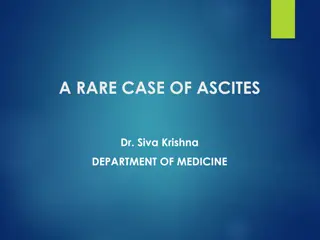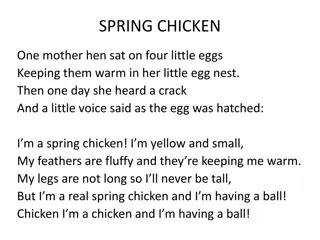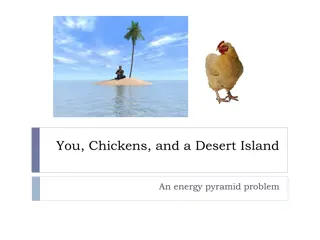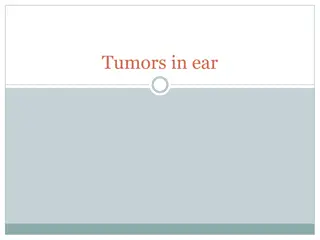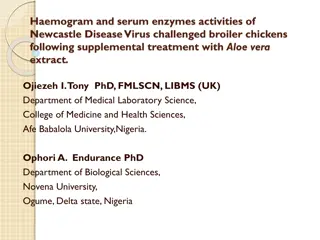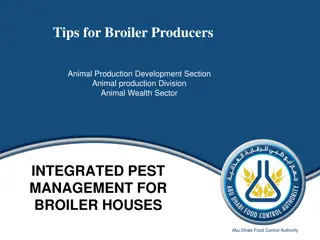Ascites in Broiler Chickens: Causes, Symptoms, and Management
Ascites is a common disease in broiler chickens, especially at high altitudes. It is characterized by fluid accumulation in the peritoneal cavity or pericardial sac, often containing yellow protein clots. Predisposing factors include reduced ventilation, high altitude, and respiratory disease. Symptoms of ascites include sudden death, poor development, weakness, abdominal distension, recumbency, dyspnea, and possible cyanosis. Lesions in affected birds show thickening of the right side myocardium, ventricle dilation, atrioventricular valve thickening, congestion, liver enlargement, and small spleen. Management strategies focus on addressing the underlying causes and improving ventilation in affected flocks.
Download Presentation

Please find below an Image/Link to download the presentation.
The content on the website is provided AS IS for your information and personal use only. It may not be sold, licensed, or shared on other websites without obtaining consent from the author. Download presentation by click this link. If you encounter any issues during the download, it is possible that the publisher has removed the file from their server.
E N D
Presentation Transcript
poultry diseases 1 fourth stage chapter one lecture 3 Ascites Dr.HarithAbdulla Department of Pathology and Poultry Disease College of veterinary medicine university of basrah University of Basrah- College of veterinary medicine- Department of Pathology and Poultry Disease
Ascites is a disease of broiler chickens occurs especially at high altitude characterized by an accumulation of transudate in the peritoneal cavity or pericardial sac. The fluid, may contain yellow protein clots.
B.P.H.S. [Broiler Pulmonary Hypertension Syndrome] . High Altitude Disease. Edema Disease. Heart Failure Syndrome. Dropsy .
Predisposing factors includes: 1-Reduced ventilation. 2- High altitude. 3- Respiratory disease. Predisposing factors includes: Morbidity: Morbidity: Is usually 1-5% . Mortality: Mortality: 1-2% but can be 30% at high altitude.
1 1- -Sudden death 2 2- -Poor development. 3 3- -Progressive weakness and abdominal distension. 4 4- -Recumbency. 5 5- -Dyspnea. 6 6- -Possibly cyanosis. Sudden death in rapidly developing birds. Poor development. Progressive weakness and abdominal distension. Recumbency. Dyspnea. Possibly cyanosis. in rapidly developing birds.
1. Thickening of right 2. Dilation of the ventricle. 3. Thickening of atrioventricular valve. 4. Generalized congestion. 5. Liver enlargement. 6. Spleen is small. 7. Pericardial effusion. Thickening of right- -side myocardium. Dilation of the ventricle. Thickening of atrioventricular valve. Generalized congestion. Liver enlargement. Spleen is small. Pericardial effusion. side myocardium. 1. 2. 3. 4. 5. 6. 7.
1 1- -Signs. 2 2- -Lesions 3 3- -Cardiac specific protein ( may be measured in the blood. Signs. Lesions: Gross pathology is characteristic. Cardiac specific protein (Troponin T) may be measured in the blood. Gross pathology is characteristic. Troponin T)
1 1- -Broiler Sudden Death Syndrome . 2 2- -Bacterial endocarditis. Broiler Sudden Death Syndrome . Bacterial endocarditis. Treatment: 1 1- -Improve ventilation. 2 2- -Vitamin C . Treatment: Improve ventilation. Vitamin C .
1 1- -Good ventilation (during incubation and chick transport). 2 2- - Avoid any genetic tendency. 3 3- - Control Good ventilation (during incubation and chick transport). Avoid any genetic tendency. Control respiratory diseases. respiratory diseases.







